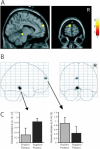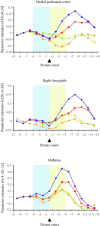Attentional modulation of emotional stimulus processing: an fMRI study using emotional expectancy
- PMID: 16317710
- PMCID: PMC6871342
- DOI: 10.1002/hbm.20209
Attentional modulation of emotional stimulus processing: an fMRI study using emotional expectancy
Abstract
We used emotional expectancy to study attentional modulation in the processing of emotional stimuli. During functional magnetic resonance imaging (fMRI), volunteers saw emotional and neutral expectancy cues signaling the subsequent presentation of corresponding emotional or neutral pictorial stimuli. As a control, emotional and neutral pictures were presented without preceding expectancy cue, resulting in a 2 x 2 factorial design with the factors "expectancy" and "emotion." Statistical analysis revealed a significant positive interaction effect between these factors in the medial prefrontal cortex (MPFC, Brodmann area [BA] 9/10), amygdala, and dorsal midbrain. In all these regions, expectancy augmented the neural response to emotional but not to neutral pictures. Time course analysis of raw data suggests that this augmented activation was not preceded by baseline increases in MPFC and amygdala during the period of emotional expectancy. In a post-scanning session, the paradigm was presented for a second time to allow emotional intensity rating. Again, a significant interaction between expectancy and emotion was observed, with intensity ratings specifically enhanced in emotional photographs preceded by expectancy. There was a positive correlation between intensity ratings and blood oxygenation level-dependent (BOLD) signals in the left amygdala. We conclude that specific components of the emotion network show enhanced activation in response to emotional stimuli when these are preceded by expectancy. This enhancement effect is not present in neutral pictures and might parallel accentuated subjective feeling states.
Figures






References
-
- Alsop D (1995): Correction of ghost artifacts and distortion in echo‐planar MR imaging with an iterative image reconstruction technique. Radiology 197: 388.
-
- Amaral DG, Price JL, Pitkanen A, Carmichael ST. 1992. Anatomical organisation of the primate amygdaloid complex In: Aggleton JP, editor. The amygdala: neurobiological aspects of emotion, memory and mental dysfunction. New York: Wiley‐Liss; p 1–66.
-
- Anderson AK, Christoff K, Stappen I, Panitz D, Ghahremani DG, Glover G, Gabrieli JD, Sobel N (2003b): Dissociated neural representations of intensity and valence in human olfaction. Nat Neurosci 6: 196–202. - PubMed
Publication types
MeSH terms
Grants and funding
LinkOut - more resources
Full Text Sources
Research Materials

